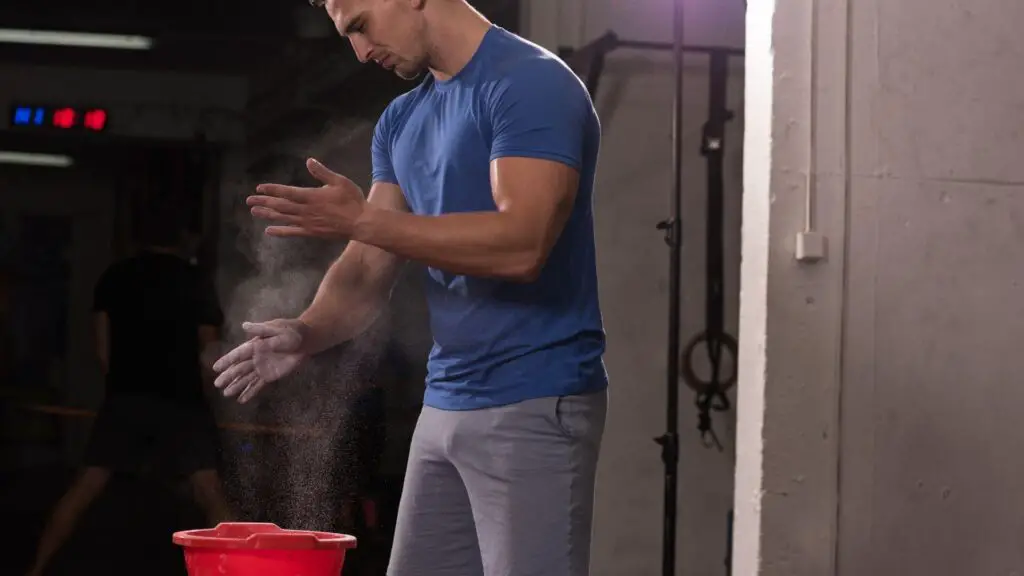Some people think gym chalk is edible, but there are serious risks if you try it out. Some of the dangers include getting chalk in your eyes, choking on it, and getting a rash from exposure to chemical chalk dust. If you are considering eating or drinking gym chalk, speak with a doctor or health professional. Afterward, it would help if you rubbed some chalk into your hands to ensure they could be dried out quickly. Gym chalk works perfectly to evaporate the sweat and allow you to do your exercises with no trouble. This article has covered the common question, “is gym chalk edible?”
Despite the possibilities and all the ifs and buts, does gym chalk have the ability to be eaten? Eating this cannot do anything but affect the process of digestion if consumed in a small amount. It can perhaps even make you ill. Gym chalk is helpful when working out, but it can also be dangerous if not used correctly. Follow these tips to avoid serious risks and stay safe while using gym chalk.
WHAT IS GYM CHALK?
Gym chalk is a white, powdery substance that contains magnesium carbonate (MgCO3). This chemical absorbs water and sweat best to give you a better grip. Limestone, oils, and drying agents are added to improve chalk’s performance.
Gym chalk is also commonly used as an athletic training aid to mark the ground during workouts in various sports.
Gym chalk typically comes in pocket size, packed in small packets or boxes containing enough material for several workouts. The chalk should be stored in a cool, dry place away from direct sunlight and heat sources. It should not be exposed to water or rain because this could cause it to become wet and muddy.
IS IT EDIBLE?
In short, gym chalk has no health risks when consumed in moderation and on an infrequent basis. However, the dust produced from the chalk might adversely affect your health and the environment if you do it occasionally. It may, for instance, cause problems for other gym-goers.
Many people believe that gym chalk is not edible. Although this may be the case for some people, others say that gym chalk can be eaten if it is consumed properly.

Gym chalk can be eaten in small amounts if mixed with water and consumed as a liquid. However, Some people may choose to avoid using gym chalk because of the potential health risks associated with its use. It is important to remember that even if chalk appears safe to eat, there is always the potential for harm if it is ingested in large quantities. Consuming large amounts of gym chalk can be dangerous. It can cause gastrointestinal troubles such as nausea, vomiting, and diarrhea. Moreover, there is talc present in some gym chalks. It can cause allergic reactions in some people.
If you do decide to eat gym chalk, it is important to take precautions.
When consuming gym chalk, it is essential to make sure that the chalk is food-grade. If the chalk does not have a label indicating edible, it should not be consumed. Additionally, wash your hands after using the chalk and avoid contact with your eyes or mouth.
THE RISKS OF EATING GYM CHALK
People with chalk or dust allergies are at serious risk. Again, those with breathing difficulties may feel unpleasant around the chalk dust in the gym. This dust is dangerous because it may transport germs from one host to another throughout the body.
Gym chalk is made of calcium carbonate, which can cause digestive problems if consumed in large quantities. Finally, even if someone does not experience any negative consequences from eating gym chalk, it is still an unappetizing substance to consume. In addition, talc can cause allergic reactions in some people. If you are concerned about these risks, it is best to avoid eating gym chalk altogether.
According to a study, constant chalk ingestion may cause the following problems:
- Cavity or tooth damage
- Troubles digesting
- The inability to pass stool, or bowel blockage
- Parasites
- Problems consuming regular meals
- And the chances of the absence of hunger
WHY USE IT IN THE GYM?
Benefits of using gym chalk
Removes Moisture from Hands:
By rubbing a light layer of chalk over your palms and fingers, you can achieve drier hands that are better able to securely hold the barbell and lift weights.
Grip Strength:
If you use chalk, you can hold a firmer grip for longer, which will help you lift more weight.
Help to stop injuries:
By smudging your hand with a piece of chalk. There will be a very slight layer produced. This layer will help keep your palm skin from tearing, especially at the tops of calluses, which tend to tear when your hands are sweaty.
HOW TO USE IT SAFELY IN GYM
Chalk is made of magnesium carbonate, which is a natural mineral. Some people have an allergy to magnesium, so it’s important to be cautious when using chalk in the gym. You can avoid any potential Allergy reactions by following these simple guidelines:
- Check with your doctor before using chalk as a piece of exercise equipment.
- Use a dust mask if you’re having trouble breathing during your workout. Chalk can cause asthma attacks in some people.
- Avoid getting chalk on your skin or in your eyes. If it does get on you, rinse it off with cool water immediately.
HOW TO STORE IT SAFELY IN THE GYM
Gym chalk is a great tool to help keep your workouts efficient and effective. However, like any other item in your gym bag, it is important to take precautions to keep gym chalk safe and healthy. Here are four ways to store gym chalk safely:
- Keep it in an airtight container: Store gym chalk in an airtight container or bag to prevent it from becoming wet or humid. This will help ensure that the chalk remains effective and avoids clumping.
- Store it in a cool place: Keep gym chalk stored at a cool room temperature, so it does not become brittle or lose its effectiveness. This will help avoid potential injuries when misusing the product.
WHAT CAN WE USE IN PLACE OF GYM CHALK?
If you’re looking for an alternative to using gym chalk, there are a few things you can use in its place. Some of these items include:
Weightlifting Straps: Lifting straps can be used to help lift heavy objects and can also be used in place of gym chalks.
Weightlifting Gloves: Gloves will help protect the hands and help avoid any injuries. It’s also a great alternative to gym chalk
Liquid Chalk: Liquid chalk is a more advanced form of gym chalk that comes in a liquid form. It’s often easier to use, and it’s also more effective during workouts.
HOW TO RUB GYM CHALK ON YOUR PALMS SAFELY:
Gym chalk works best when dry palms are brought to it. Otherwise, the chalk will yield a messy glue-type substance from the moisture on your skin instead of assisting you. If you’re looking for a safe and easy way to apply gym chalk to your palms, you can use a dry cloth before applying it. First, simply place the dry towel or cloth over your palms. Then, use smooth, circular motions to spread the chalk evenly across your palms.
FINAL THOUGHTS:
It is essential to thoroughly rub chalk into your palms or use protective gear if you spend a lot of time working out at the gym. If you do not take precautions, there is always a chance that you may drop the heavyweights, which might lead to severe injuries.
You should never use ordinary chalk if you have been diagnosed with an allergy to gym chalk. As a substitute, you can use weightlifting gloves or any other material that can absorb water in place of the substations.

